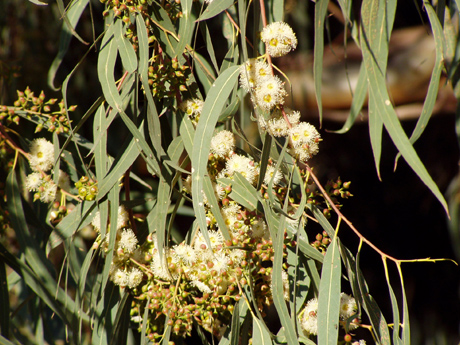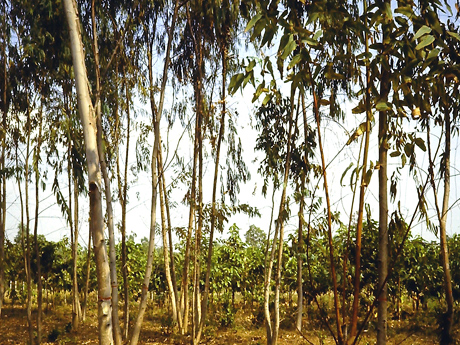Eucalyptus wood




Source plants
- scientific name
- Eucalyptus camaldulensis Dehnh.
Synonym: Bombax pentandrum L.、 Ceiba anfractuosa (DC.) M.Gómez - general name
- Red river gum, River red gum, Long beak eucalyptus, Murray red gum
- overview
-
It is a type of eucalyptus, which originated in Australia. It is generally a mid to tall tree of 20 m in height and 1m in breast-height diameter, but in some cases it reaches 50 m and breast-height diameter of 2 m. When it grows naturally, it has a short, thick trunk and forms a wide-spreading crown. Being resistant to dryness and acidity, it is one of the tree species that are the most planted in dry land and poor soil. In its natural habitat, it is mainly found along drainage systems and on flood plains. It grows under a wide range of climatic conditions from temperate to tropical, from humid to dry regions, and shows maximum growth in areas of loamy or silty soil deriving from clay and where ground water is available. This species does not form sleeping buds and grows whenever conditions are good.
Containerized seedlings are usually used for planting. For the purpose of fuel production, it is planted at intervals of 2 x 2 m or 3 x 3 m. To produce props, poles, and fuel, planting density should be managed at the level of 700 seedlings/ha or less for five-year old trees, and to produce lumber, qualitative thinning should be done to leave well-shaped trees and harvest at 10 years old or older. By planting seedlings of growing areas and species suitable for site conditions, it is possible to have growth of 3 m or more per annum. Seedlings of some growing areas and species are easily coppiced. They are coppiced in a six-year cycle or longer. In suitable places, they are managed by coppicing in a 7-to-10-year cycle in suitable places.
It produces a large amount of nectar, which has a unique flavor and is of pale gold color. Having high strength and excellent durability, it is used for various forms of structural materials such as railroad ties, poles, flooring, shore protection materials, ship timbers, and construction materials. Firewood produced from planted young trees burns fast and haslow durability, but naturally grown trees make high grade fuelwood as they have a nice aroma and burn for a long time. Eucalyptus wood is excellent for charcoal. Even planted young trees can make charcoal of good quality. Its fibers are long and strong and used for pulp and the raw material of paper. It is also planted for the purpose of producing raw material for hardboard, fiberboard, and particle board. Since its oil constituent has a refreshing scent and bactericidal effect, it is used as a preservative. Of this species, the variety growing in the tropics contains plenty of 1,8-cineol, has excellent pharmaceutical quality, and is an important source of traded eucalyptus oil.
Product characteristics
- use
- Pulp chips, building materials, fuel (charcoal, pellets, and firewood), beekeeping (source of honey), essential oil (eucalyptus oil)
- area
- Planted widely in Australia (country of origin) and tropical areas all over the world
- overview
-
Annual increase in the volume of eucalyptus wood per hectare is reported to be 20-25 m3 in Argentina, 30 m3 in Israel, 17-20 m3 in the first cutting cycle and 25-30 m3 after that in Turkey, and 45-60 m3 on average in intensive plantations in Brazil in recent years. On the other hand, the yield from 14-15-year-old trees amounted only to 2-11 m3/ha in dry areas in India, where the growth volume is small. In Southeast Asia, Thailand for example, it is 25 m3/ha per annum on land in good condition and 8 m3/ha per annum on poor land.
New demand as energy material
Generally in Southeast Asia, for example in Thailand, 70-80% of planted eucalyptus are turned into pulp chips, 10-15% into fuel and 5% into poles for buildings (props). In recent years, there is a growing demand as a source of biomass energy from energy-related industries.
In joint research conducted by Thailand and Japan, it is proposed to strike a balance between improvement of farmers’ livelihoods and reduction of carbon dioxide emissions by planting eucalyptus on unused agricultural land (land that has been abandoned and is no longer cultivated) to produce charcoal (Kawasaki et al. 2014). In Thailand, there are several companies that sell and produce eucalyptus charcoal. P.K.Trading exports white charcoal. Thailand has traditionally received technical support in charcoal making from Japan and the Thai-Iwate kiln is commonly used. Comparing the quality of charcoal at a carbonization temperature of 500, 600, and 700 degrees C using this kiln, the quality at 700 degrees C was as good as binchotan charcoal (high-grade charcoal produced from ubame oak) with 85% of high-density carbon fixation (Chotikhum & Laemsak 2009). Also, a production method of briquettes not using tapioca starch is developed and they are being produced (photo 2). Lumber to be used is 3-5 years old, and currently it is possible to produce 50 t a month and the price is around 120 yen/kg (heard at Kasetsart University). Furthermore, wood vinegar of eucalyptus is used for production of creosote. Meanwhile, eucalyptus pellets are produced in countries such as Thailand, Vietnam, and Indonesia with capital injection from South Korea. New demand for eucalyptus wood has been generated.
Price trends of chip and pole materials, and charcoal (examples in Thailand)
Chips produced in Thailand are exported to Japan and Taiwan. In the case of Chiang Rai in northern Thailand, production of chips is becoming less appealing to farmers as the price of chips (850 baht (24 USD)/ton) is lower than that of pole materials (1500 baht (42 USD)/ton). At the same time, it is estimated that, if eucalyptus is planted in land that has been abandoned and is no longer cultivated, 0.965 t/ha of trunk will be cropped in the third year and 1,351 USD/ha of earnings will be generated by making charcoal with it (Kawasaki et al. 2014). It cannot be compared directly as their volume is wet weight, but even after considering moisture content, it is obviously advantageous for producers (farmers) to make charcoal. In Japan, charcoal made from planted eucalyptus from Thailand is now sold at 200-300 yen/kg, which is less expensive than domestic charcoal made from broad leaved trees.
- 参考情報
-
- Orwa et al. (2009) Agroforestry Database 4.0、 World Agroforestry Centre http://www.worldagroforestry.org/treedb/index.php?speciesname=B http://www.worldagroforestry.org/treedb/AFTPDFS/Eucalyptus_camaldulensis.pdf
- James A. Duke. 1983. Handbook of Energy Crops (Eucalyptus camaldulensis Schlecht.). http://www.hort.purdue.edu/newcrop/duke_energy/Eucalyptus_camaldulensis.html
- ユーカリ・カマルドレンシス植林による木炭生産とその経済性(タイ語)タイ王室森林局、1997
- Rockwood, DL, AW Rudie, SA Ralph, JY Zhu, JE Winandy (2008) Energy Product Options for Eucalyptus Species Grown as Short Rotation Woody Crops. Molecular Sciences 9: 9, 1361-1378
- Elmagboul,A., W. Kritsanaphan, S. Niemi, Priyanto, M. Tynkkynen, M. Ulfah, J. Zhu, E. Varis. (Moderators: Dr. D. Pipatwattanakul & S. A. Alam) (2008) PLANTATION FORESTRY IN THAILAND (TEAK, RUBBERWOOD, EUCALYPT) CASE STUDY IN CHIANG RAI PROVINCE, 33pp.
- Kawasaki, J., T. Silalertruksa, M. Yamanoshita, H. Scheyvens (2014) Economic and climate benefits from utilization of unused farmlands for eucalyptus plantations and charcoal production in Thailand. The ISSAAS International Congress 2014, 8-10 November 2014, Tokyo, Japan, 12pp.
- アジア・バイオマス・オフィス(2009)タイおよびインドネシアで木質ペレット製造プラント建設
https://www.asiabiomass.jp/topics/0905_02.html - 炭助 http://www.sumisuke.com/index.html


